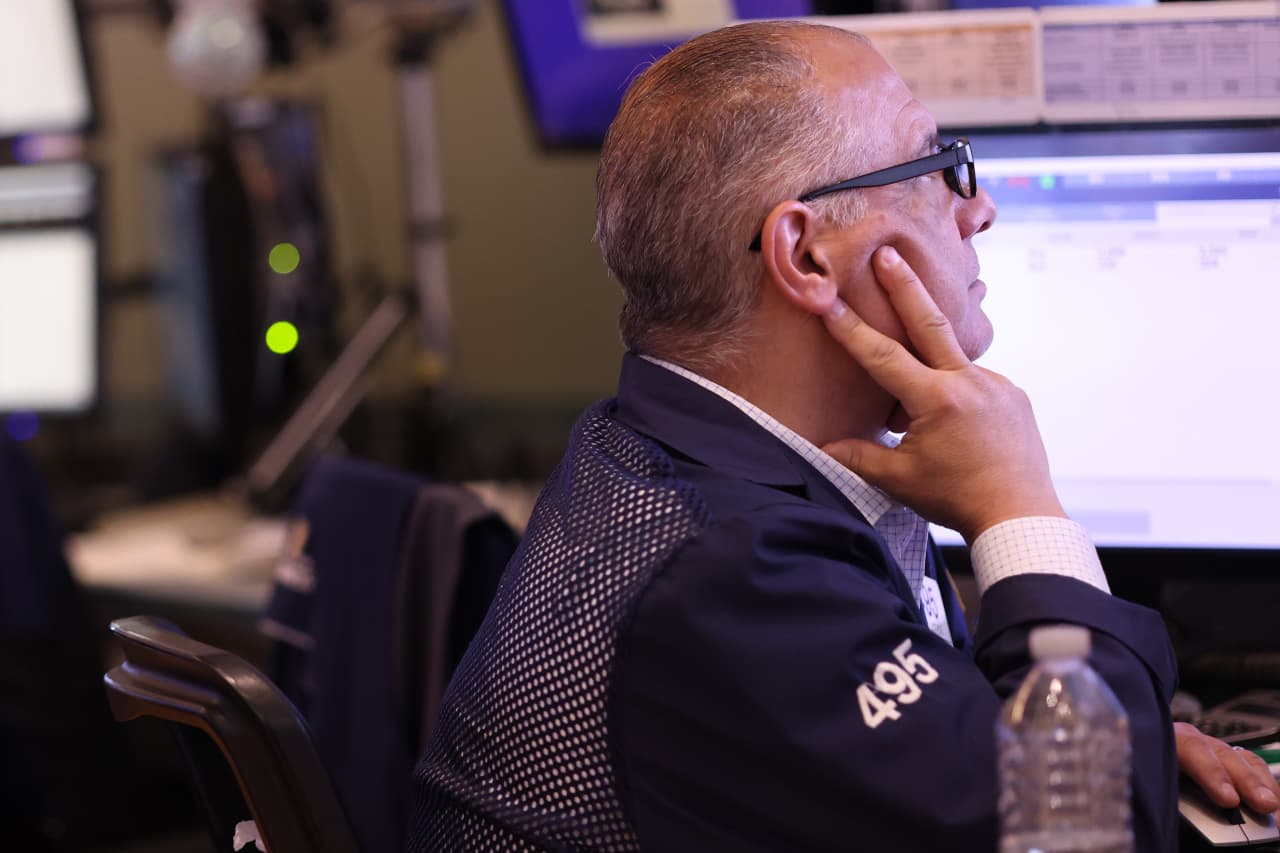Stocks Are Wobbling. Follow These 3 Rules for Better Returns.
Suddenly, stocks look shaky. After briefly touching 40,000 earlier this month, the Dow has since shed more than 1,000 points, as worries flare about where interest rates are headed next . The index posted another loss on Wednesday, down 411 points, or 1.06%, to 38,442.
While volatility can be frustrating. It has always been part of the two-steps forward, one-step back nature of the stock market. So keep in mind: Stocks may still have room to run , and they perform their best when investors feel least confident.
Here are three smart rules for interpreting the current market culled from new stock research.
Don’t assume the market is in a bubble
Anytime the market hits a new high, then pulls back sharply, it’s natural to wonder: Could it be all downhill from here? It isn’t an idle concern. Even after the recent dip, stocks are trading at more than 25 times trailing 12-month earnings, their highest level since 2021, according to FactSet.
Still, investors shouldn’t necessarily assume the market has become irrational, suggests a recent note by Leuthold Group, a stock research firm known for compiling dozens of bespoke indicators to measure market sentiment.
Leuthold recently compared large capitalisation stock prices to four separate valuation thresholds it thinks mark out bubble territory.
The results? This year, prices have approached three of these thresholds—one focused on forecast earnings, one based on average earnings and one based on cash flow. But after getting close, stocks didn’t blow through these thresholds as might be expected during a bubble. Instead, they stalled or pulled back. “‘Resistance’ proves formidable,” the firm concluded, citing a term common in technical analysis.
The fourth valuation threshold, which Leuthold calls “P/E on trailing peak GAAP EPS” has yet to be reached. The indicator compares stock prices not to companies’ most recent earnings, but to the market’s record for earnings, in this case set in the first quarter of 2022.
While stocks are trading at 25 times their peak earnings—a very high figure by historical standards—they are still below the 30 times level Leuthold thinks signals bubble territory. The upshot: “We don’t think U.S. large caps quite qualify as a mania,” writes Chief Investment Officer Doug Ramsey.
Don’t sweat the short-term
It’s natural after a short, sharp pullback to worry where the market is headed next. But trying to make short-term market calls is usually a fool’s errand, according to Trivariate Research, another investment firm.
Trivariate recently tested more than two dozen stock market metrics it says are commonly used to predict short-term stock market declines. These indicators included the S&P 500 put-to-call ratio, mutual fund flows, the futures-based VIX fear gauge, the price of oil and more.
The results were “terrible,” according to the firm. “The factors’ large loss predictions were correct at about the same rate as random selection,” Trivariate said in its note.
The firm found that during many months when signals like the VIX and the Conference Board’s Leading Economic Indicators Index predicted a big drop, the market actually showed bigger-than-average gains. The indicators were signalling volatility not declines, the firm noted.
In another test, a model that Trivariate built based on several other indicators also wasn’t much help either. When the model predicted a large stock market loss, defined as a 2.5% monthly drop, the decline failed to materialise 60% of the time.
Do embrace the uncertainty
While uncertainty isn’t always comfortable, it can be to investors’ advantage. If you are willing to run with it.
Retired Wall Street economist Jim Paulsen points to a metric known as the Monetary Policy Uncertainty Index , which tallies newspaper reports and other data to measure uncertainty about what the Fed will do next.
Since 1985 the index has averaged just under 100, but since 2020 it has been elevated most of the time. It’s currently at 144, a higher level than during about 80% of its history.
Still, Paulsen argues this is good news. He compares the Fed’s Jerome Powell era, where the index has averaged 110, to eras of three earlier Fed Chairs: Ben Bernanke, Janet Yellen, and Alan Greenspan, where it averaged about 75.
Investors have been rewarded for enduring the lack of clarity. The S&P 500 has posted average annual returns of more than 12% during Powell’s term, compared with less than 10% under his three predecessors, according to the note.
“All investors long for clarity,” Paulsen writes. “But the stock market never does that well when you and I are comfortable. The great bulk of the returns generated by the stock market typically occur when most are still in their bunkers waiting for conditions to improve.”
 Copyright 2020, Dow Jones & Company, Inc. All Rights Reserved Worldwide. LEARN MORE
Copyright 2020, Dow Jones & Company, Inc. All Rights Reserved Worldwide. LEARN MORE
This stylish family home combines a classic palette and finishes with a flexible floorplan
Just 55 minutes from Sydney, make this your creative getaway located in the majestic Hawkesbury region.
Continued stagflation and cost of living pressures are causing couples to think twice about starting a family, new data has revealed, with long term impacts expected
Australia is in the midst of a ‘baby recession’ with preliminary estimates showing the number of births in 2023 fell by more than four percent to the lowest level since 2006, according to KPMG. The consultancy firm says this reflects the impact of cost-of-living pressures on the feasibility of younger Australians starting a family.
KPMG estimates that 289,100 babies were born in 2023. This compares to 300,684 babies in 2022 and 309,996 in 2021, according to the Australian Bureau of Statistics (ABS). KPMG urban economist Terry Rawnsley said weak economic growth often leads to a reduced number of births. In 2023, ABS data shows gross domestic product (GDP) fell to 1.5 percent. Despite the population growing by 2.5 percent in 2023, GDP on a per capita basis went into negative territory, down one percent over the 12 months.
“Birth rates provide insight into long-term population growth as well as the current confidence of Australian families,” said Mr Rawnsley. “We haven’t seen such a sharp drop in births in Australia since the period of economic stagflation in the 1970s, which coincided with the initial widespread adoption of the contraceptive pill.”
Mr Rawnsley said many Australian couples delayed starting a family while the pandemic played out in 2020. The number of births fell from 305,832 in 2019 to 294,369 in 2020. Then in 2021, strong employment and vast amounts of stimulus money, along with high household savings due to lockdowns, gave couples better financial means to have a baby. This led to a rebound in births.
However, the re-opening of the global economy in 2022 led to soaring inflation. By the start of 2023, the Australian consumer price index (CPI) had risen to its highest level since 1990 at 7.8 percent per annum. By that stage, the Reserve Bank had already commenced an aggressive rate-hiking strategy to fight inflation and had raised the cash rate every month between May and December 2022.
Five more rate hikes during 2023 put further pressure on couples with mortgages and put the brakes on family formation. “This combination of the pandemic and rapid economic changes explains the spike and subsequent sharp decline in birth rates we have observed over the past four years,” Mr Rawnsley said.
The impact of high costs of living on couples’ decision to have a baby is highlighted in births data for the capital cities. KPMG estimates there were 60,860 births in Sydney in 2023, down 8.6 percent from 2019. There were 56,270 births in Melbourne, down 7.3 percent. In Perth, there were 25,020 births, down 6 percent, while in Brisbane there were 30,250 births, down 4.3 percent. Canberra was the only capital city where there was no fall in the number of births in 2023 compared to 2019.
“CPI growth in Canberra has been slightly subdued compared to that in other major cities, and the economic outlook has remained strong,” Mr Rawnsley said. “This means families have not been hurting as much as those in other capital cities, and in turn, we’ve seen a stabilisation of births in the ACT.”
This stylish family home combines a classic palette and finishes with a flexible floorplan
Just 55 minutes from Sydney, make this your creative getaway located in the majestic Hawkesbury region.






















